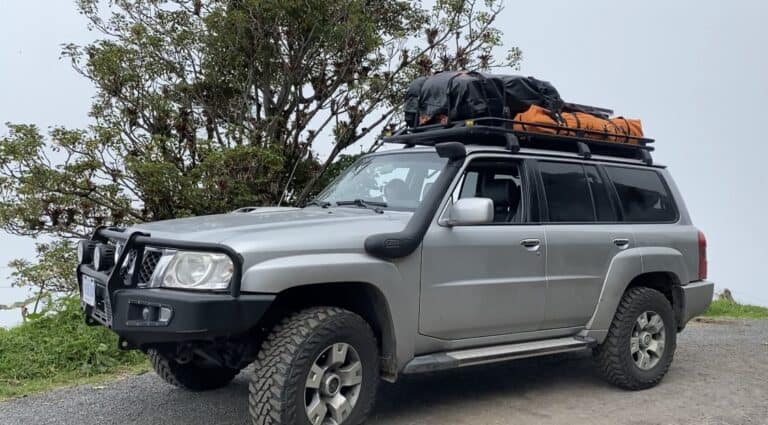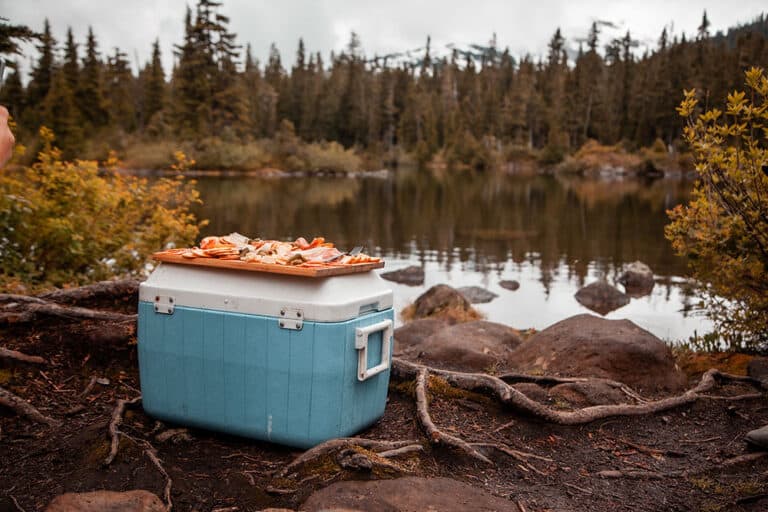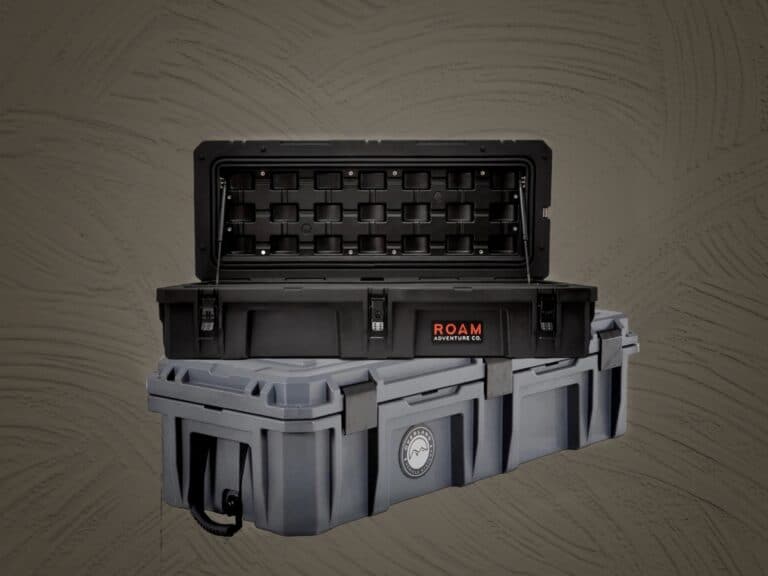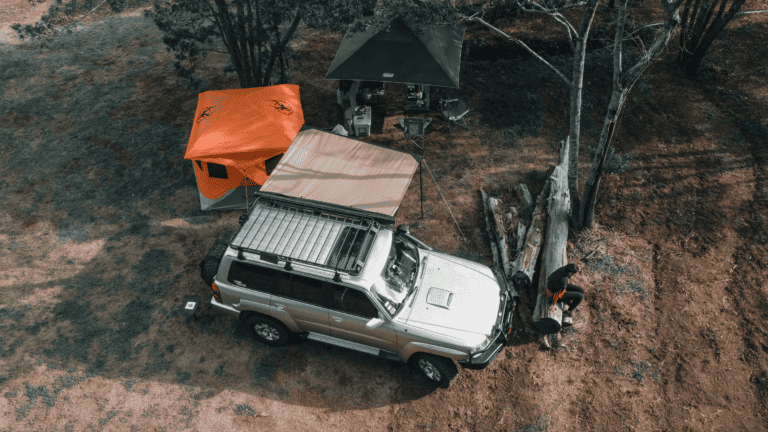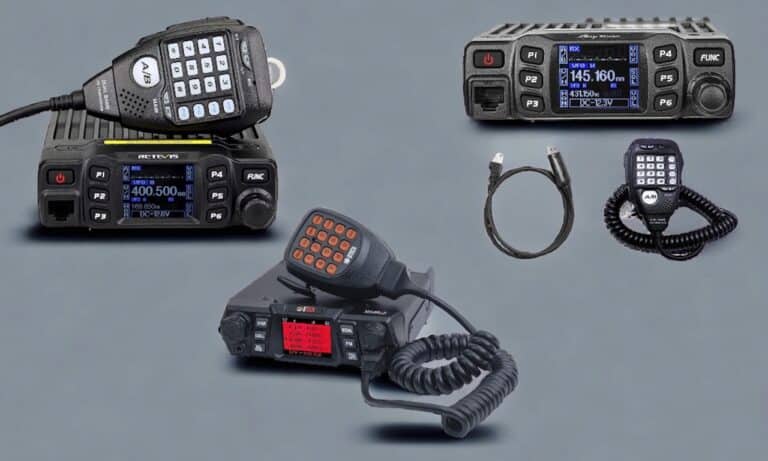Best Winches for Overlanding 2024
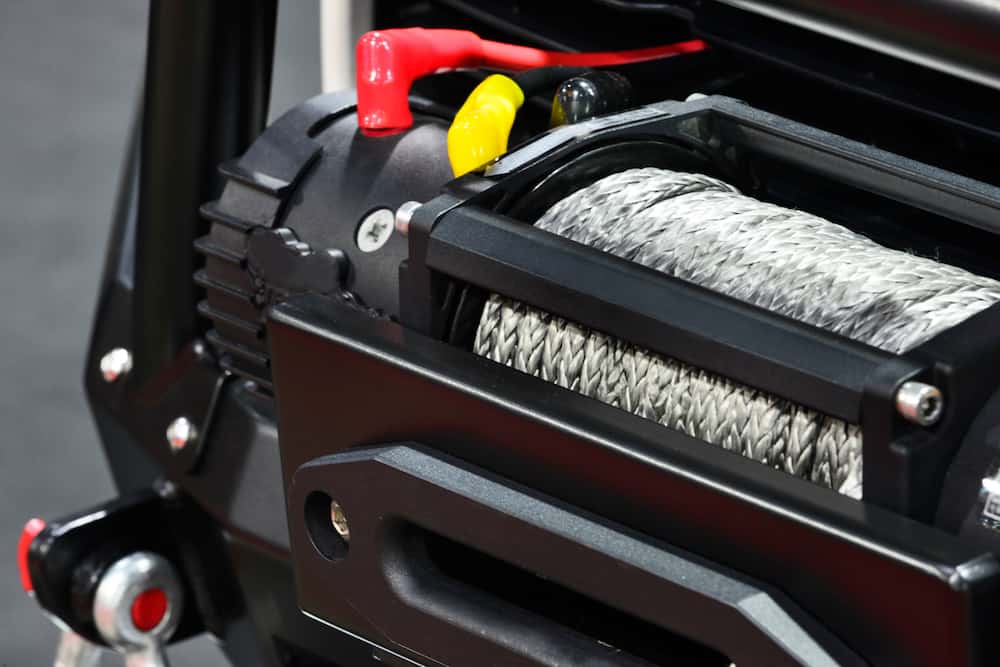
Overlanding enthusiasts, get ready for an adventure like no other with the best winches for Overlanding 2024! These reliable and powerful pieces of equipment will be your greatest ally while you travel difficult terrain and overcome difficult challenges in the bush. With their exceptional strength and durability, winches are designed to withstand the toughest conditions, ensuring that you can confidently explore any off-road destination.
Imagine yourself driving through vast deserts, dense forests, or steep mountain trails. Suddenly, you find yourself stuck in a deep mud pit or stranded on a rocky slope. Winches are incredibly strong pullers with innovative features that make it easy to pull your car out of any situation. Whether you’re embarking on a solo adventure or traveling with a group of fellow overlanders, having a reliable winch is essential for safety and peace of mind.
Prepare and gear up for an extraordinary journey with the best winches for Overlanding 2024.
The Basics of Overlanding Winches
Overlanding winches are essential tools for off-road enthusiasts. What is a winch? It is a mechanical device used to pull heavy loads or vehicles out of tough situations. Types of winches vary, but electric and hydraulic winches are the most common. Electric winches are easier to install and operate, while hydraulic winches offer more power. When choosing a winch, consider factors like weight capacity, line speed, and durability. How to choose a winch is a crucial step in ensuring you have the right tool for your off-roading adventures.
What is a winch?
Picture this: You’re out in the wilderness, miles away from civilization. Your vehicle is stuck in the mud, its tires spinning helplessly. The rain is pouring, and the wind is howling. It seems like there’s no way out. But wait, what’s that? A winch! A trusty companion that can come to your rescue in times of need.
A winch is a powerful device that is mounted on the front or rear of a vehicle. It consists of a motor, a drum, and a cable. When engaged, the winch uses its motor to wind the cable onto the drum, exerting a tremendous amount of pulling force. This force can be used to free a stuck vehicle or to pull heavy objects.
Types of Winches
As we dive deeper into the world of overlanding winches, let’s explore the different types that are available. Overlanding winches come in various forms, each designed to cater to specific needs and situations.
Electric winches are the most common type found in the overlanding community. They are powered by the vehicle’s battery and offer impressive pulling power. These winches are easy to use with a simple push-button operation, making them a popular choice for overlanders of all experience levels.
Hydraulic winches utilize the power of the vehicle’s power steering pump. They provide consistent pulling power and are well-suited for heavy-duty applications. These winches are known for their durability and reliability, making them a top choice for those who frequently tackle challenging terrains.
Features to Look for in a Winch for Overlanding
When considering a winch for overlanding, there are several important features to look for. Winch capacity is key, as it determines how much weight the winch can handle. A winch with a higher capacity can handle heavier loads, providing peace of mind on challenging off-road adventures. Winch strength is also crucial, as it determines the winch’s pulling power. Look for a winch with a high strength rating to ensure it can handle the toughest situations. Design and construction are important too, as a well-built winch will be more durable and reliable.
Winch Capacity
One of the first things to consider when selecting an overlanding winch is its capacity. This refers to the maximum weight the winch can handle. Imagine yourself deep in the wilderness, facing a challenging situation where your vehicle is stuck in mud or on a steep incline. In such moments, you need a winch with sufficient capacity to pull your vehicle out of trouble.
When it comes to winch capacity, it’s important to consider the weight of your vehicle and any additional equipment you may have. A general rule of thumb is to choose a winch with a capacity that is 1.5 times the weight of your vehicle. This ensures that you have enough power to overcome any obstacles you may encounter.
Winch Strength
As we move on to discuss the features to look for in a winch for overlanding, one crucial aspect to consider is winch strength. When you find yourself in the wilderness, facing challenging terrain, a winch with robust strength becomes your reliable companion.
Winch strength refers to the pulling power and durability of the winch. It determines the ability to recover your vehicle from tough situations. A winch with significant strength ensures that you can tackle even the most demanding off-road adventures with confidence.
Look for a winch that boasts a high line pull rating. This indicates the maximum weight the winch can pull without strain. Additionally, consider the winch’s gear ratio, as it directly impacts its pulling power. A winch with a lower gear ratio provides greater strength, allowing you to overcome obstacles effortlessly.
Furthermore, winch strength is also influenced by the quality of its construction. Opt for a winch made from sturdy materials such as high-grade steel for enhanced durability.
Design and Construction
As you embark on your overlanding adventures, it is important to equip yourself with a winch that not only has the right capacity and strength but also boasts a well-designed and sturdy construction.
Design and construction play a crucial role in ensuring the reliability and durability of an overlanding winch. When browsing for the perfect winch, keep an eye out for features that enhance its performance and longevity.
One key aspect of the design to consider is the housing. Look for winches with a sturdy and corrosion-resistant housing, typically made of tough materials like aluminum or steel. This ensures that your winch can withstand the elements and rough off-road conditions.
Another important design feature is the drum. A smooth and properly aligned drum is essential for smooth and efficient winching. Make sure the drum is made of high-quality materials and has a good grip to prevent any slippage during operation.
Sealing is also an important consideration.
Cable or Synthetic Rope?
When it comes to choosing between cable and synthetic rope, there are several factors to consider. Benefits of Synthetic Rope include its lightweight and high strength-to-weight ratio, making it easier to handle and transport. It is also resistant to corrosion and UV rays, ensuring durability in various weather conditions. On the other hand, the benefits of Steel Cable lie in its superior strength and durability, making it ideal for heavy-duty applications. Additionally, it has a longer lifespan and is less susceptible to wear and tear. Determining the right choice depends on factors such as the specific application, load capacity, and budget.
Benefits of Synthetic Rope
Synthetic rope, made from materials such as Dyneema or Amsteel, has become increasingly popular in the world of overlanding for several reasons. One of the main benefits is its lightweight nature. As you embark on your off-road journeys, every pound counts, and synthetic rope weighs significantly less than its steel cable counterpart. This means less strain on your vehicle and easier handling when it comes time to use your winch.
Another advantage of synthetic rope is its flexibility. Unlike steel cable, which can kink and become rigid over time, synthetic rope retains its pliability and is less prone to tangling. This makes it easier to manipulate and store, giving you peace of mind knowing that your rope is always in top condition.
Additionally, synthetic rope is safer to use. In the event of a failure, steel cable can snap back with extreme force, causing serious injury or damage.
Benefits of Steel Cable
While synthetic rope may have its advantages, steel cable also offers a number of benefits for overlanding enthusiasts. One of the key benefits of steel cable is its durability and strength. Made from high-tensile steel, it can withstand the harshest conditions and toughest pulls. Whether you’re navigating through rocky terrain or pulling your vehicle out of deep mud, steel cable is built to handle the challenge.
Another advantage of steel cable is its resistance to abrasion and UV damage. Over time, synthetic ropes can wear out or become damaged from exposure to rough surfaces or prolonged sun exposure. Steel cable, on the other hand, is more resistant to these types of damage, making it a reliable choice for off-road adventures.
Furthermore, steel cable is generally easier to maintain. With synthetic rope, you may need to regularly inspect and clean it to prevent dirt, sand, or moisture from compromising its integrity. In contrast, steel cable requires less maintenance and can be cleaned with simple soap and water.
Determining the Right Choice
When deciding between synthetic rope and steel cable, it’s crucial to evaluate your specific needs. If you frequently venture into wet or corrosive environments, synthetic rope may be the better option. Its resistance to rust and rot makes it ideal for these conditions. Additionally, synthetic rope is lightweight, making it easier to handle and transport.
On the other hand, if you prioritize durability and strength, steel cable might be the right choice for you. It can withstand harsh conditions, such as excessive heat or sharp edges, without compromising its performance. Furthermore, steel cable is less prone to fraying or abrasion, ensuring its longevity.
Ultimately, the decision comes down to personal preference.
Electric or Hydraulic?
Electric or hydraulic? When it comes to winches, it can be a tough decision. Let’s explore the pros and cons of each option. Electric winches are known for their ease of use and quiet operation. They are also more compact and lightweight, making them ideal for smaller vehicles. However, they can drain the battery quickly and may struggle with heavy loads. On the other hand, hydraulic winches are powerful and reliable, capable of handling heavy-duty tasks. They are less likely to overheat and can be operated for longer periods. However, they require a hydraulic system and can be more expensive.
Pros and Cons of Electric Winches
After considering whether to use a cable or synthetic rope, it’s time to turn our attention to the next important decision: electric or hydraulic winches. The choice between these two options can greatly impact the performance and efficiency of your winching system. So, let’s dive into the pros and cons of electric winches.
Electric winches offer a host of advantages that make them a popular choice for many off-roaders. First and foremost, they are incredibly convenient. With just the push of a button, you can effortlessly control the winch, making it ideal for solo adventures. Additionally, electric winches are lightweight and compact, making them easy to install and transport.
Another major benefit of electric winches is their impressive pulling power. They are capable of exerting immense force, allowing you to tackle even the toughest recovery situations. Furthermore, electric winches are quieter compared to their hydraulic counterparts, ensuring a more peaceful off-roading experience.
Pros and Cons of Hydraulic Winches
While electric winches have their advantages, hydraulic winches offer a unique set of benefits that make them a compelling choice in certain situations.
One of the main advantages of hydraulic winches is their sheer power. These winches are capable of exerting an incredible amount of force, making them ideal for heavy-duty applications. Whether you need to pull a large vehicle out of a muddy ditch or lift a heavy load onto a trailer, a hydraulic winch will get the job done with ease.
Another advantage of hydraulic winches is their durability and reliability. These winches are designed to withstand harsh conditions and heavy use, making them a great choice for off-road enthusiasts and industrial applications. With proper maintenance, a hydraulic winch can last for many years, providing you with peace of mind and a reliable tool when you need it most.
However, hydraulic winches do have some drawbacks that should be considered as weight, and they require a hydraulic system to operate effectively.
Factors to Consider when Selecting a Winch
When selecting a winch, there are a few key factors to consider. Winch Price Point is an important consideration, as it determines whether the winch fits within your budget. Next, Winch Weight comes into play. You’ll want to choose a winch that is lightweight yet powerful enough to handle your needs. Finally, Winch Durability is crucial, as you’ll want a winch that can withstand tough conditions and last for years to come.
Winch Price Point
The price of a winch can vary greatly depending on its features, quality, and brand. Winches come in a wide range of prices, from budget-friendly options to high-end models. It’s essential to find a winch that fits within your budget while still meeting your requirements. Keep in mind that a higher price doesn’t always guarantee better performance, so it’s crucial to evaluate the winch’s features and reputation.
When considering the winch price point, it’s essential to think about the long-term value and potential savings. While a cheaper winch may seem like a good deal initially, it may lack the durability and reliability needed for heavy-duty use. Investing in a higher-priced winch with a proven track record can save you money in the long run by reducing the need for frequent repairs or replacements.
Winch Weight
When considering the selection of a winch, winch weight plays a crucial role in determining the overall effectiveness and portability of the device. The weight of a winch can greatly impact its ease of use and maneuverability, making it an important factor to consider.
Winch weight can vary significantly depending on the type and size of the winch. Smaller winches are generally lightweight, making them easier to transport and install. These compact winches are ideal for off-road enthusiasts who frequently move from one location to another, as they can be easily carried and mounted on different vehicles.
On the other hand, larger winches tend to be heavier due to their robust construction and increased pulling capacity. While they may pose a challenge in terms of portability, their weight is often a testament to their durability and ability to handle heavier loads. These heavy-duty winches are perfect for industrial applications or when dealing with larger vehicles.
Winch Durability
When selecting a winch, it is important to consider its durability. A winch that is built to withstand tough conditions and heavy usage will be a valuable asset in any operation. Durability is determined by the quality of materials used in its construction, as well as the design and engineering behind it.
Winch Durability
Durability is key when it comes to winches. A winch that is not built to last will quickly become a liability. It is important to choose a winch that is made from high-quality materials, such as stainless steel or heavy-duty aluminum, which can withstand the elements and heavy loads.
Additionally, the design and engineering of the winch play a crucial role in its durability. A winch that is poorly designed may have weak points that can break under pressure or fail to perform as expected. On the other hand, a well-designed winch will have reinforced components and robust mechanisms that can handle the toughest tasks.
Top 5 Winches I Recommend
Now that we have discussed the important factors to consider when selecting a winch, let me share with you my top 5 winch recommendations.
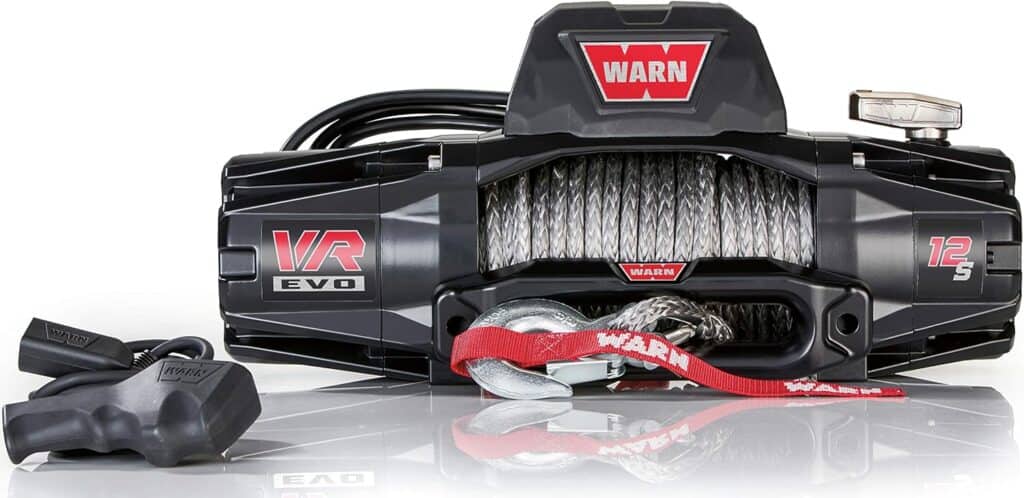
Warn 103255 Vr Evo Winch with Synthetic Rope
The perfect balance between performance, power, and quality! For those seeking a reliable winch at an exceptional price, the Warn 103255 Vr Evo is the best choice.
- With a 12,000 lb. pulling capacity, this winch can handle heavy loads effortlessly.
- The synthetic rope is not only strong and durable, but it also provides excellent resistance to UV rays, chemicals, and abrasion.
- Equipped with a powerful 12V DC motor, this winch delivers reliable and consistent power for all your pulling needs.
The WARN 103255 VR EVO 12-S is designed with the latest technology to ensure smooth and efficient operation. Its integrated control pack allows for easy mounting and provides excellent protection against the elements.
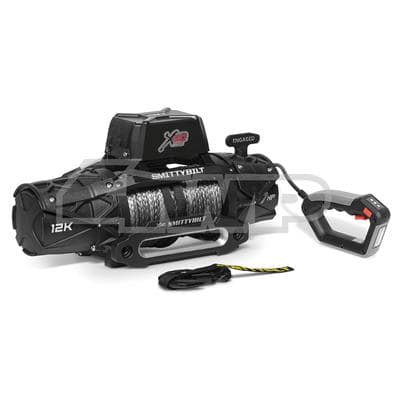
Smittybilt XRC GEN3 12K with Synthetic Rope
Smittybilt has always been known for their high-quality off-road accessories, and their XRC GEN3 winch is no exception. This winch is not only powerful but also packed with features that make it a top choice for any off-roader.
It has a 12,000-pound capacity, making it suitable for heavy-duty applications.
It comes with a wireless remote control, allowing you to operate the winch from a safe distance.
The winch is equipped with a series wound motor, which delivers high torque and fast line speed.
It has a 3-stage planetary gear system, providing smooth and reliable operation.
It has a durable and waterproof construction, ensuring that it can withstand harsh weather conditions.
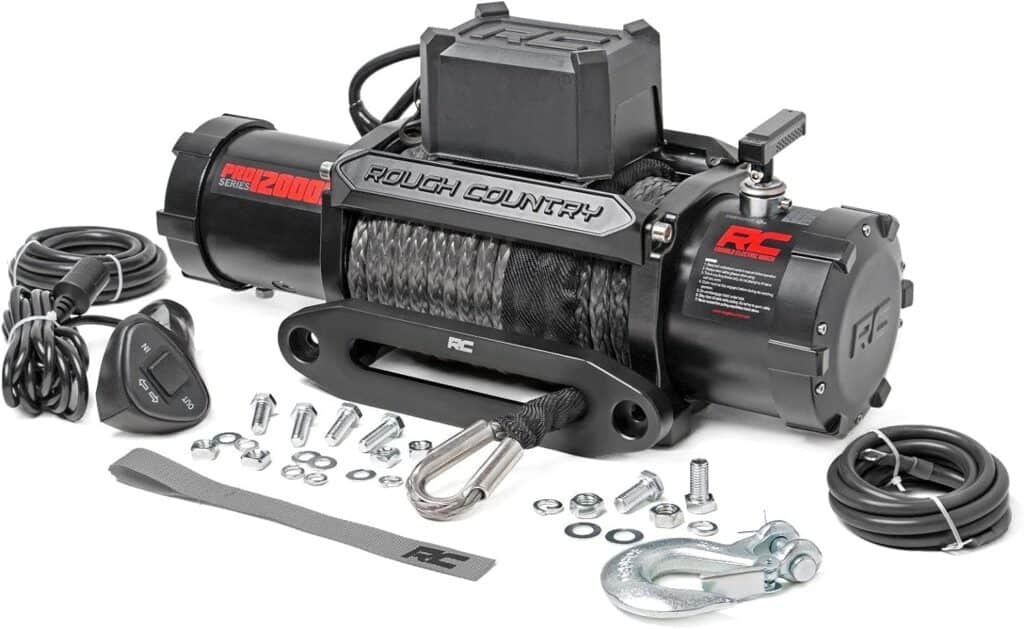
Rough Country 12,000lb Pro Series Synthetic Rope
In the world of winches, the Rough Country 12,000LB PRO Series Electric Winch with Synthetic Rope is a true champion. With its robust design and powerful performance, this winch is a force to be reckoned with.
Key Features of the Rough Country 12,000LB PRO Series Electric Winch:
- 12,000LB Load Capacity: This winch is built to handle heavy-duty tasks with ease. Whether you’re pulling a stuck vehicle out of a muddy trail or hauling a heavy load, this winch has got you covered.
- Synthetic Rope: The synthetic rope used in this winch is not only strong and durable but also lightweight. It provides excellent resistance against abrasion and is less prone to snapping, ensuring a safe and reliable operation.
- Remote Control: Controlling this winch is a breeze with the included wireless remote control. You can operate the winch from a safe distance, allowing you to stay out of harm’s way while still getting the job done.
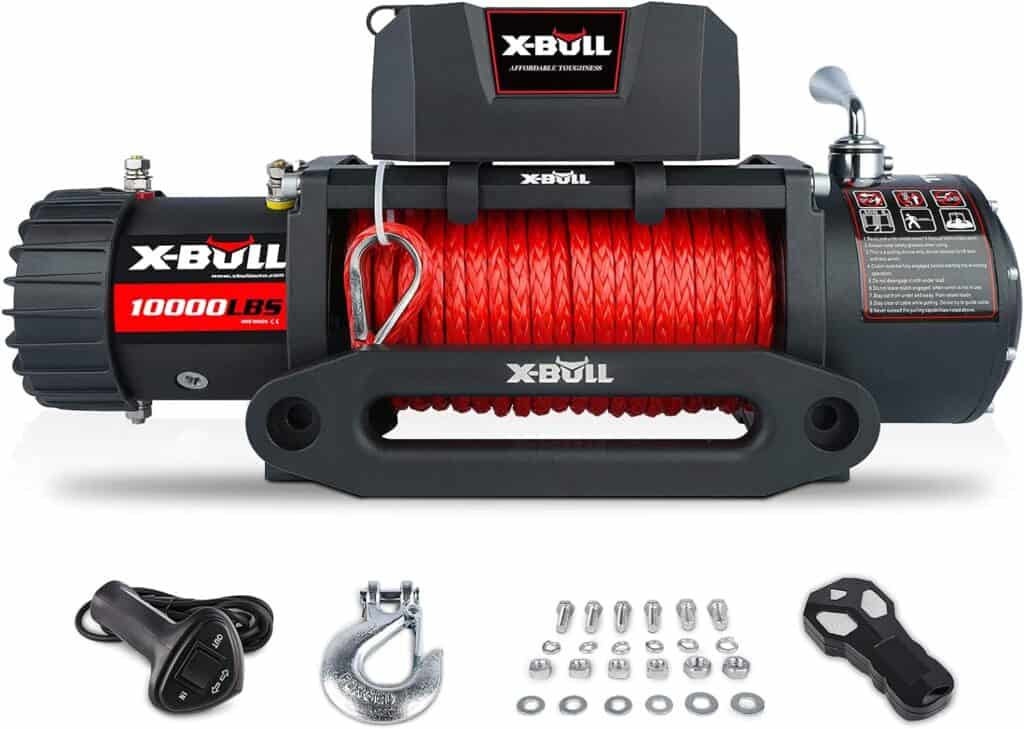
X-Bull Winch-10,000lb Synthetic Rope
It’s possible to find something affordable that still works the way you want it to, and this model from X-Bull goes above and beyond what you expect.
This powerful winch is designed to handle heavy loads and provide reliable performance in challenging situations. With its 12V synthetic rope, it offers durability and strength to tackle any task that comes its way.
Here are some standout features of the X-BULL Winch-10000 lb. Load Capacity Electric Winch Kit:
- Impressive Load Capacity: With a load capacity of 10,000 lbs, this winch is capable of handling even the toughest jobs.
- Efficient Power: The 12V motor delivers sufficient power to pull heavy objects with ease.
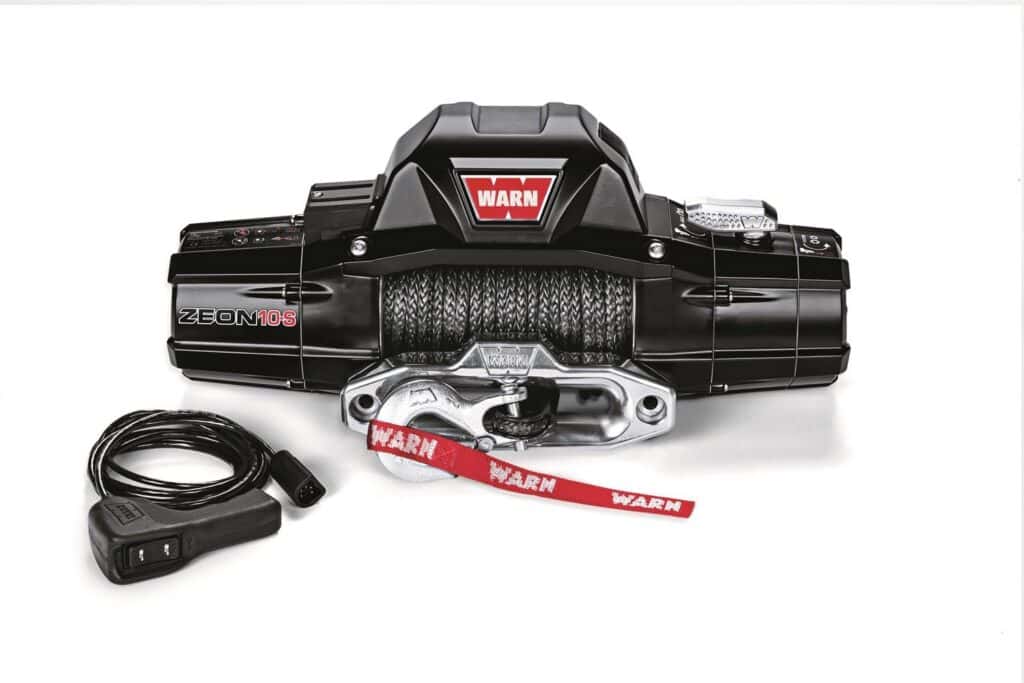
Warn 89611 ZEON 10-S Winch with Synthetic Rope – 10000 lb. Capacity
Are you looking for the best quality? Probably one of the best options out there, but with a high price range. Look no further if you can afford it!
The new Warn Zeon winch changes things forever. Tough enough to tackle anything you will, with a look that is advanced, capable, and strong. Zeon is a design masterpiece that defines the next generation of winches from Warn Industries. Features include a durable satin-black cast-aluminum housing, muck-busting sealing, and a convertible control pack that lets you mount the winch the way you want. Add a powerful new motor, a hyper-durable finish, and an efficient new gear train, and, well, you’ve got a workhorse unit you can trust for years to come.
- Uniquely balanced 10000 pounds winch with synthetic rope and roller fairlead
- Design is consistent throughout the entire winch with the same look on the motor as on the gear side
- Convertible control pack can be attached to winch or remotely mounted allowing for various mounting options
- Black powder-coated finish and stainless steel fasteners and clutch inhibit corrosion
- Large aluminum winch drum is lightweight and reduces rope wear
Also Read: 5 Best Roof Racks for Overlanding
Safety Considerations
Inspecting the Winch: First and foremost, before using the winch, it is crucial to inspect it thoroughly. Check for any signs of wear and tear, such as frayed cables or loose bolts. Pay close attention to the drum and make sure it is free from any debris or dirt that could affect its performance. Installing the Winch: Once you have completed the inspection, it’s time to install the winch securely. Ensure that it is attached to a strong and stable anchor point capable of withstanding the load. Using the winch properly:
Inspecting the Winch
Inspecting the winch is a simple yet vital task that should never be overlooked. Begin by examining the cable or rope for any signs of wear and tear. Look closely for frayed strands or kinks that could weaken its strength. Next, check the winch drum for any signs of rust or damage. A smooth and clean drum is crucial for a seamless operation. Don’t forget to inspect the fairlead as well, ensuring it is intact and securely attached.
Moving on, examine the control switch and wiring for any signs of damage or loose connections. Make sure the remote control is functioning properly before you hit the trails.
Installing the Winch
Installing the winch is a crucial process that requires attention to detail and precision. Before you begin, make sure you have all the necessary tools and equipment at hand. Start by locating a sturdy mounting point on your vehicle, such as the front bumper or a dedicated winch mount.
Carefully position the winch onto the mounting point, ensuring that it is aligned properly. Secure it tightly using the provided bolts and hardware. Double-check the tightness of the bolts to ensure that the winch is securely fastened.
Next, attach the winch cable to the designated anchor point on your vehicle. Make sure it is tightly secured to prevent any slippage during operation.
Finally, connect the winch to a reliable power source, such as your vehicle’s battery.
Using the Winch Properly
Now that you have your winch installed and ready to go, it’s important to understand how to use it properly to ensure your safety and the safety of others. When it comes to using the winch, there are a few key things to keep in mind.
First, always make sure you have a clear understanding of the winch’s load capacity. Exceeding the load capacity can put unnecessary strain on the winch and potentially cause it to fail. Remember, safety should always be your top priority.
Second, before you begin using the winch, carefully inspect the area. Look for any potential hazards or obstacles that might interfere with the winching process. It’s crucial to clear the area and create a safe working environment.
Third, maintain constant supervision while operating the winch. Keep a close eye on the load and the winching process to ensure everything is going smoothly. If you notice any issues or abnormalities, stop immediately and reassess the situation.
Maintenance and Troubleshooting
Maintenance and troubleshooting are crucial for the proper functioning of any equipment, and a winch is no exception. To ensure your winch operates smoothly, three key subtopics need to be explored: Cleaning and Lubrication, Troubleshooting the Winch, and Repairing and Replacing Parts.
Cleaning and Lubrication
One crucial aspect of maintenance is cleaning and lubrication. Imagine your winch as a well-oiled machine, smoothly gliding through its tasks. To achieve this, regular cleaning and lubrication are key.
Cleaning is the first step in keeping your winch in top condition. Begin by removing any dirt, debris, or grime that may have accumulated during use. Gently brush away the surface dirt using a soft-bristle brush. Pay close attention to the nooks and crannies where dirt tends to hide. Next, use a mild detergent diluted in warm water to wipe down the winch, ensuring a thorough clean. Rinse it with clean water and allow it to dry completely before moving on to the next step.
Lubrication is the secret to keeping your winch operating smoothly. Apply a high-quality lubricant specifically designed for winches to all moving parts.
Troubleshooting the Winch
After ensuring that your winch is clean and properly lubricated, it’s time to dive into troubleshooting any potential issues that may arise. Troubleshooting the winch can be a breeze if you know what to look for and how to address the problem.
First, check the power source. Is the winch receiving enough power to operate? Ensure that the battery is fully charged and the connections are secure. If the winch still isn’t working, move on to the next step.
Next, inspect the control switch. Is it functioning properly? Sometimes, a faulty switch can be the culprit behind a non-responsive winch. If necessary, replace the switch and test the winch again.
If the winch is still not working, it’s time to examine the motor. Is it making any unusual noises? Is it overheating? These signs may indicate a motor problem that needs to be addressed by a professional.
Finally, check the cables and connections. Over time, these can become worn or loose, resulting in poor performance.
Repairing and Replacing Parts
When it comes to repairing and replacing parts on your winch, it’s important to have a keen eye for detail. Begin by carefully examining the component in question, checking for any signs of wear or damage. If you notice any cracks, fraying, or corrosion, it’s time to replace the part.
To ensure a smooth repair process, always refer to the manufacturer’s instructions. These invaluable guides will provide you with step-by-step instructions, ensuring that you correctly disassemble and reassemble the winch. Remember to work methodically and keep track of each part you remove.
When replacing parts, it’s crucial to source high-quality, genuine components.
Conclusion
In conclusion, finding the best winch for overlanding in 2024 is crucial for a successful off-road adventure. With the right winch, you can confidently tackle any obstacle and ensure the safety of yourself and your vehicle. Remember to consider the features that will best suit your needs, such as cable or synthetic rope and electric or hydraulic power.
When selecting a winch, it’s important to take into account factors such as weight capacity, line speed, and durability. The top five winches recommended in this article have been carefully chosen for their reliability and performance in various overlanding scenarios.
Safety should always be a top priority when using a winch. Always follow proper installation and operation procedures to prevent accidents and injuries. Regular maintenance and troubleshooting will also help extend the life of your winch and ensure its optimal performance.
Remember, investing in a high-quality winch is an investment in your overlanding adventures. So, choose wisely and enjoy the thrill of exploring new terrain with peace of mind.
Disclosure: This post may contain affiliate links. If you use these links to buy, we may earn a small commission at no additional cost to you. Thanks for your support!

